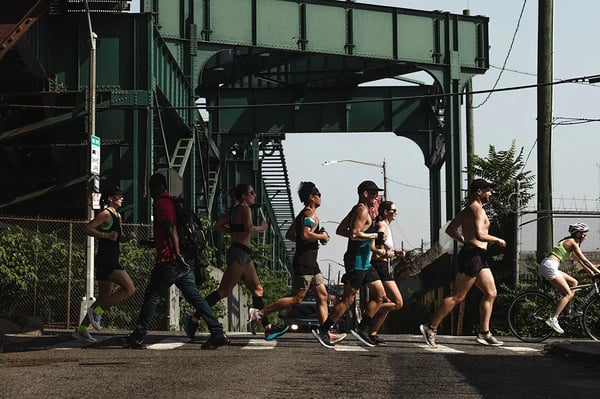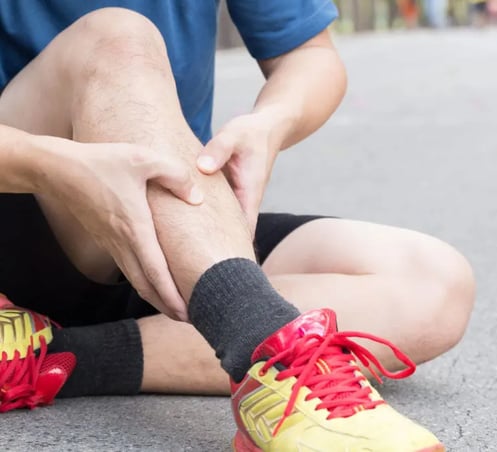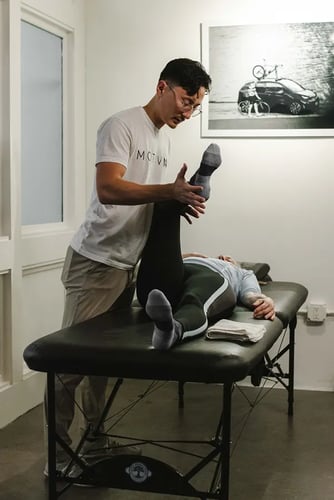Too Much, Too Soon: Shin Splints in Runners
August 23, 2022
Summer is coming to an end, and as temperatures cool, running outside will start to look a little less intimidating. Some of you may be looking to maintain the momentum built over the summer. Many of you are ramping up the mileage in preparation to race this fall. And some of you are just getting going again after taking a break from the heat.

In an ideal world, you would follow the diligent advice of an experienced coach. But if you're like so many of us who picked up running for how convenient and accessible it is, you probably found a free generic program online or are simply "winging it."
While we love to see more runners hit the pavement, it also means seeing an influx of patients coming in for Physical Therapy with lower body injuries. Among the most common injuries that plague runners, Medial Tibial Stress Syndrome (MTSS), AKA "Shin Splints," tops the list as having the highest incidence rate, ranging from 13.6% to 20%, and is one of the most common causes of exercise-induced lower leg pain (1).
High Pain, No Gain
Although there is still debate about the exact cause of shin splints, this condition is characterized by pain in the lower two-thirds of the tibia bone coupled with point tenderness of at least 5 cm in length (2). The onset of pain typically occurs following a sudden increase in training volume and is thought to be a bone stress reaction resulting from the classic "too much, too soon" mistake most runners make.

Shin splints are especially challenging to deal with because individuals won't experience the typical "warm-up effect" commonly found in conditions involving tendons such as Achilles tendinopathy. No matter how much you warm up for your run, it will hurt, and running more won't make it feel any better.
When we stress our bones through training, an associated level of micro-damage occurs, similar to when we train muscles. As long as the body has sufficient time and nutrients to recover, bones will remodel stronger. Suppose the amount of micro-damage exceeds the body's ability to heal, and there is a cumulative effect from excessive training stress. In that case, bone stress injuries can occur (4) which ultimately need time to heal.
Now you might think, "Well, I have a high pain tolerance!"
Sorry to say, but you're not doing yourself any favors by trudging through your training program. One study that allowed participants diagnosed with shin splints to run with a 4/10 pain found that it took upwards of 100 days to return to 20 minutes of high-intensity running, leading to a 20% dropout and low satisfaction by the end of the program(3).
The Poison is the Antidote
 If you're dealing with shin splints, the first thing you need to do is modify your training volume to reduce excessive impact. That might mean cutting out running altogether to allow the body to heal. Although this suggestion is typically met with resistance, we at MOTIVNY believe in collaborating with our patients and working together to develop an individual plan that helps build cardiovascular fitness and athletic performance without adding more mileage. We accomplish this by introducing alternative means of stressing the body to increase athletic capacity and to promote positive physiological adaptation with sufficient recovery.
If you're dealing with shin splints, the first thing you need to do is modify your training volume to reduce excessive impact. That might mean cutting out running altogether to allow the body to heal. Although this suggestion is typically met with resistance, we at MOTIVNY believe in collaborating with our patients and working together to develop an individual plan that helps build cardiovascular fitness and athletic performance without adding more mileage. We accomplish this by introducing alternative means of stressing the body to increase athletic capacity and to promote positive physiological adaptation with sufficient recovery.
As much as stress is the culprit for this condition, it is also the cure, and we just need to find the proper dosage. Finding that optimal amount of stress and load takes diligent planning that takes the individual into consideration.
It’s a Marathon, Not a Sprint
Running is all about playing the long game. While some of you are in it for the thrill of competition, many will continue to reap the health benefits for the rest of your lives.
If you're dealing with shin pain preventing you from running, don't push through it. Get assessed by a Physical Therapist and determine how you can address your athletic needs without sacrificing performance.
References:
1. Lopes AD, Hespanhol Júnior LC, Yeung SS, Costa LO. What are the main running-related musculoskeletal injuries? A Systematic Review. Sports Med. 2012;42(10):891-905. doi:10.1007/BF03262301
2. Yates B, White S. The Incidence and Risk Factors in the Development of Medial Tibial Stress Syndrome among Naval Recruits. The American Journal of Sports Medicine. 2004;32(3):772-780. doi:10.1177/0095399703258776
3. Moen MH, Holtslag L, Bakker E, et al. The treatment of medial tibial stress syndrome in athletes; a randomized clinical trial. Sports Med Arthrosc Rehabil Ther Technol. 2012;4:12. Published 2012 Mar 30. doi:10.1186/1758-2555-4-12
4. Warden SJ, Edwards WB, Willy RW. Preventing Bone Stress Injuries in Runners with Optimal Workload. Curr Osteoporos Rep. 2021;19(3):298-307. doi:10.1007/s11914-021-00666-y
